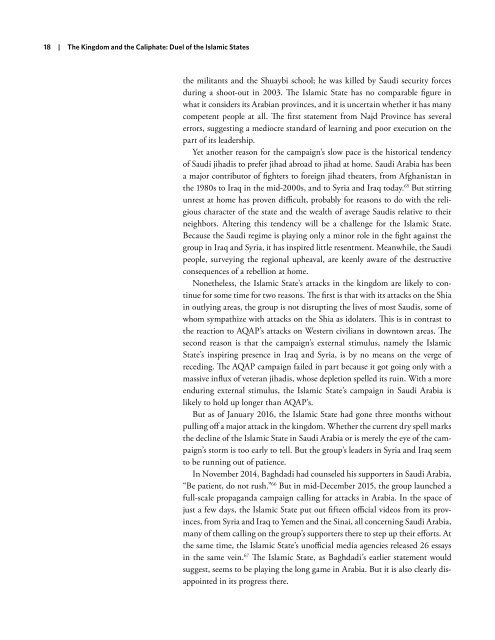You also want an ePaper? Increase the reach of your titles
YUMPU automatically turns print PDFs into web optimized ePapers that Google loves.
18 | The Kingdom and the Caliphate: Duel of the Islamic States<br />
the militants and the Shuaybi school; he was killed by Saudi security forces<br />
during a shoot-out in 2003. The Islamic State has no comparable figure in<br />
what it considers its Arabian provinces, and it is uncertain whether it has many<br />
competent people at all. The first statement from Najd Province has several<br />
errors, suggesting a mediocre standard of learning and poor execution on the<br />
part of its leadership.<br />
Yet another reason for the campaign’s slow pace is the historical tendency<br />
of Saudi jihadis to prefer jihad abroad to jihad at home. Saudi Arabia has been<br />
a major contributor of fighters to foreign jihad theaters, from Afghanistan in<br />
the 1980s to Iraq in the mid-2000s, and to Syria and Iraq today. 65 But stirring<br />
unrest at home has proven difficult, probably for reasons to do with the religious<br />
character of the state and the wealth of average Saudis relative to their<br />
neighbors. Altering this tendency will be a challenge for the Islamic State.<br />
Because the Saudi regime is playing only a minor role in the fight against the<br />
group in Iraq and Syria, it has inspired little resentment. Meanwhile, the Saudi<br />
people, surveying the regional upheaval, are keenly aware of the destructive<br />
consequences of a rebellion at home.<br />
Nonetheless, the Islamic State’s attacks in the kingdom are likely to continue<br />
for some time for two reasons. The first is that with its attacks on the Shia<br />
in outlying areas, the group is not disrupting the lives of most Saudis, some of<br />
whom sympathize with attacks on the Shia as idolaters. This is in contrast to<br />
the reaction to AQAP’s attacks on Western civilians in downtown areas. The<br />
second reason is that the campaign’s external stimulus, namely the Islamic<br />
State’s inspiring presence in Iraq and Syria, is by no means on the verge of<br />
receding. The AQAP campaign failed in part because it got going only with a<br />
massive influx of veteran jihadis, whose depletion spelled its ruin. With a more<br />
enduring external stimulus, the Islamic State’s campaign in Saudi Arabia is<br />
likely to hold up longer than AQAP’s.<br />
But as of January 2016, the Islamic State had gone three months without<br />
pulling off a major attack in the kingdom. Whether the current dry spell marks<br />
the decline of the Islamic State in Saudi Arabia or is merely the eye of the campaign’s<br />
storm is too early to tell. But the group’s leaders in Syria and Iraq seem<br />
to be running out of patience.<br />
In November 2014, Baghdadi had counseled his supporters in Saudi Arabia,<br />
“Be patient, do not rush.” 66 But in mid-December 2015, the group launched a<br />
full-scale propaganda campaign calling for attacks in Arabia. In the space of<br />
just a few days, the Islamic State put out fifteen official videos from its provinces,<br />
from Syria and Iraq to Yemen and the Sinai, all concerning Saudi Arabia,<br />
many of them calling on the group’s supporters there to step up their efforts. At<br />
the same time, the Islamic State’s unofficial media agencies released 26 essays<br />
in the same vein. 67 The Islamic State, as Baghdadi’s earlier statement would<br />
suggest, seems to be playing the long game in Arabia. But it is also clearly disappointed<br />
in its progress there.



